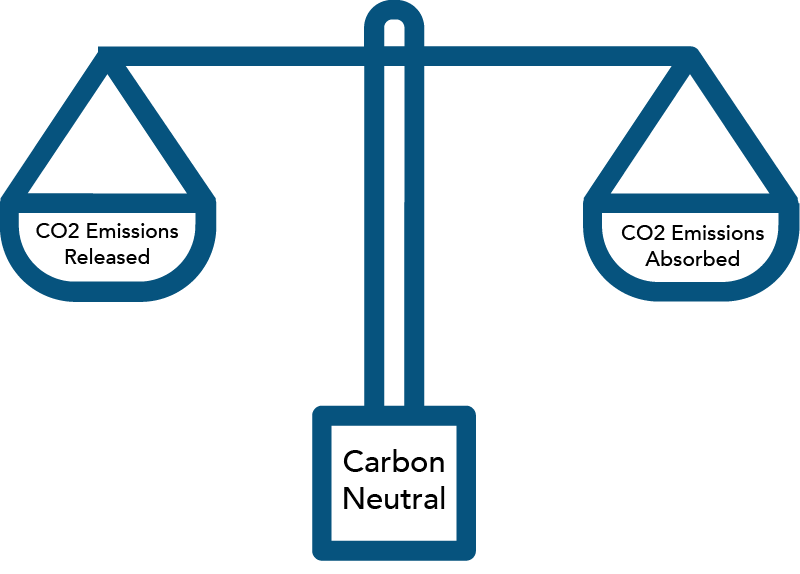Net Zero is a concept we hear everywhere. People, countries and companies are all talking about decarbonising, and some of them are actually decarbonising. Some claim to be Carbon Neutral, some on the path to what’s known as Net Zero and some claim to be Carbon Neutral in their Net Zero plan. But is a Carbon Neutral strategy the same thing as a Net Zero Strategy?
The quick answer is no, Carbon Neutral and Net Zero are not the same thing. They are similar but have different strategies and can’t be used interchangeably. So here’s a breakdown that you don’t need a PhD to understand.
Carbon Neutral
Let’s start with the basics, Carbon Neutrality simply means that any CO2 released into the atmosphere is then balanced by the equivalent being removed.

Carbon Neutral strategies often consider carbon sinks as well as carbon capture and storage to create this balance. A carbon sink is something which absorbs more carbon than it emits, aka oceans, soils and forests. But the drawback here is that the carbon is released into the atmosphere before it’s absorbed. Things can get a little sketchy here if the carbon absorption happens down the track from the emissions activity, and that adds to the carbon legacy. Carbon Neutral also only considers the industrial operational emissions, or Scope 1 and 2 emissions. Emission scopes are a whole new can of worms, but here’s the simple rundown:
| Scope 1 | Direct emissions owned or controlled by the company |
| Scope 2 | Indirect emissions associated with the production of energy purchased by a company |
| Scope 3 | Indirect emissions associated with a company’s activities including supply chain and upstream and downstream emissions. This can include purchased goods, commutes, waste disposal, business travel, use of sold goods and more. |
Given its neglect of indirect emissions and that offsets can be untimely and unreliable, the idea of Net Zero was formed.
Net Zero
Here’s where things get juicy. While both Carbon Neutral and Net Zero are reducing emissions in the atmosphere, net zero is working towards zero emissions being released, period. That means zero Greenhouse Gasses (GHG) including:
- zero carbon dioxide (CO2)
- zero methane (CH4)
- zero ozone (O3) and;
- zero nitrous oxide (N20).
It is far more comprehensive, and probably one of the most ambitious sustainability strategies out there. It considers all 3 emissions scopes: direct emissions, energy source and indirect activities. If the addition of scope 3 doesn’t sound like a big deal, it is. Imagine all of the emissions associated with sourcing raw materials (upstream) and distribution of products (downstream). That involves taking complete responsibility for the supply chain and operations that aren’t core business. On average, Scope 3 emissions are 11x higher than Scope 1 or 2 (CDP). In combination with scope 1 and 2, we’re looking at the complete picture of emissions.
At its core, Net Zero relies on lowering emissions as much as possible (as much as 95% for many industries) and then turning to carbon sinks and offsets for the emissions that can’t be avoided. That should sound like the big picture of emissions, and it is. Here’s why.
Net Zero is linked to the Paris Agreement because ultimately, it’s the point at which global warming stops. It is the true point where humans are no longer adding to atmospheric distress. Of course, our atmosphere still holds all of the carbon we’ve burdened it with throughout history (our carbon legacy, also explained below). However, this “balance between anthropogenic emissions by sources and removals by sinks of greenhouse gasses in the second half of this century” as the Paris Agreement Highlights is crucial because if achieved by 2050, global emissions can stay under the 1.5 celcius. In other words, we’ll avoid the most disastrous and catastrophic effects of climate change.
Reaching Net Zero
Net Zero is achievable in theory, and complex in practice. It can be estimated with carbon footprint calculations and should include 100% of Scope 1 and Scope 2 emissions and all Scope 3 emissions that contribute to more than 1% of its total footprint.
If an organization is not able to provide neutral or negative carbon balance within its process/product design, it can purchase carbon credits. These of course must be equivalent to emissions released and don’t require emissions reductions to have taken place, making them a last resort.
Science has backed many technologies and solutions to all 3 scope emissions. A few of which are shown here.
| Scope | Emissions considered in the scope | Solutions to minimise |
| Scope 1 | Direct emissions owned or controlled by the company | Direct co2 capture at the production point |
| Scope 2 | Indirect emissions associated with the production of energy purchased by a company | Renewable energy sources Optimisation (increase efficiency means less running time) |
| Scope 3 | Indirect emissions associated with a company’s activities including supply chain and upstream and downstream emissions. | Engage with vendors to set targets and drive change |
Reducing 100% of emissions is a complex challenge. That’s probably why we refer to it as “net” instead of “absolute” zero. What is clear as day though, is that we need drastic and widespread emissions reductions. We need Net Zero strategies to be effective and permanent. That is, industries with a carbon-negative approach to reaching net zero, not just a reliance on offsets. We need solutions that adequately repurpose or store carbon safely, where it can’t return to the atmosphere. We need countries to implement policies, companies to adopt plans and investment to back promising technologies that can accelerate the path to Net Zero.

